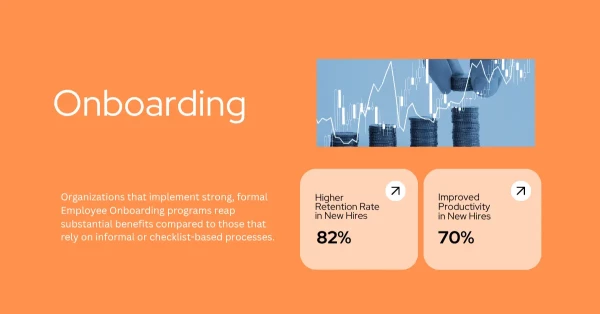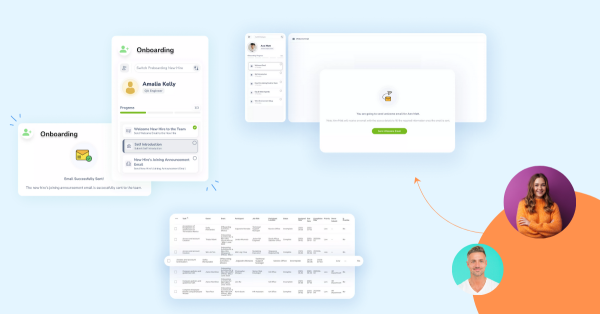Effective Employee Onboarding has transcended its former role as a simple administrative checklist to become one of the most critical components of Talent Management and a strategic driver of organizational success. In today's competitive talent market, the initial experience a new employee has is often the single greatest determinant of their long-term Employee Retention and future Time-to-Productivity.
A robust onboarding program ensures that new hires are not merely processed, but are fully integrated into the Organizational Culture, equipped with the necessary knowledge, and psychologically prepared to contribute meaningfully. This article provides an objective and comprehensive analysis of the factors, strategies, challenges, and necessary tradeoffs involved in crafting a world-class New Hire Experience that aligns with overarching business goals.
The Strategic Imperative: Why Onboarding Matters
The success of an organization is fundamentally linked to how quickly and effectively new employees transition into their roles. Data conclusively shows that investing in a positive onboarding experience yields tangible returns across key business metrics.
Key Factors Impacting Onboarding Success
-
Employee Retention: The early months of employment are a high-risk period for turnover. When employees feel unsupported, confused, or disconnected, they are likely to seek opportunities elsewhere. Conversely, a positive experience builds immediate commitment.
-
Time-to-Productivity (TTP): This metric measures the duration it takes for a new hire to reach full proficiency and deliver expected output. Optimized onboarding cuts TTP, converting the cost of a new hire into revenue generation faster.
-
Cultural Assimilation and Engagement: Onboarding is the primary vehicle for transmitting Organizational Culture, values, and behavioral norms. Successful integration leads to higher job satisfaction and better team cohesion.
-
Compliance and Risk Mitigation: A structured process ensures all necessary legal, safety, and policy documentation (Compliance) is completed and understood, minimizing organizational risk. For example, tools like contract generators or electronic signature platforms can streamline the creation and signing of employment contracts, ensuring they are legally sound and reducing administrative burden. These tools help automate the process, improving both accuracy and efficiency in handling critical documents.
Data Spotlight: The ROI of Structured Onboarding

Organizations that implement strong, formal Employee Onboarding programs reap substantial benefits compared to those that rely on informal or checklist-based processes.
|
Onboarding Program Impact |
Quantitative Improvement |
Source |
|
New Hire Retention |
82% higher retention rates for new hires |
Brandon Hall Group |
|
New Hire Productivity |
70% improved productivity for new hires |
Brandon Hall Group |
|
Employee Satisfaction |
Employees are 2.6x more likely to feel satisfied at work |
Gallup |
|
Long-Term Stay |
69% of employees are more likely to stay 3+ years |
SHRM |
|
Turnover Cost |
Poor onboarding contributes to replacement costs up to 200% of an employee's salary |
SHRM |
Actionable Tips Across the Onboarding Continuum
Effective onboarding is not a one-day event; it is a holistic process extending well into the first year, broken down into three critical phases.
1. Phase Zero: Pre-boarding (Offer Acceptance to Day One)
The Pre-boarding phase is where engagement begins, minimizing the risk of "ghosting" (candidates accepting offers but failing to show up) and maximizing Time-to-Productivity.
|
Strategic Tip |
Why It Works |
Challenge/Tradeoff |
|
Automate Digital Paperwork |
Collecting HR forms, bank details, and compliance acknowledgments digitally and in advance reduces first-day stress, allowing the new hire to focus on people, not paperwork. |
Tradeoff: Efficiency vs. Personal Touch. Over-automation can feel cold. Balance digital forms with a personal, human touch like a welcome video. |
|
Manager-Initiated Outreach |
The direct manager should contact the new hire personally. This confirms excitement and establishes the manager as the primary support person, not just HR. |
Challenge: Managers may be too busy. Requires clear HR Technology support to create automated reminders and templates for managers. |
|
The Welcome Kit |
Sending company swag, necessary equipment (laptop, monitor, desk chair for remote roles), and an IT access guide before the start date ensures the employee is logistically ready to work on Day One. |
Challenge: Logistics and budget complexity, especially for international or remote hires. Requires coordination between HR, IT, and shipping/procurement. |
2. Phase One: The Critical First Week (Day One to Day Seven)
The first week is where the new employee forms their lasting impression of the Organizational Culture and their team. The focus must be on relationships and clarity.
-
The Seamless First Day: Ensure the workstation is ready, access cards work, and necessary software accounts are active. A staggering 43% of new employees wait more than a week for their working tools, leading to immediate frustration (isEazy).
-
Structured Social Integration: Assign an Onboarding Buddy (a non-managerial peer) to help navigate the unwritten rules and social networks. Studies show that meeting a buddy more than eight times in the first 90 days significantly improves productivity.
-
Role Clarity and Goal Setting: The direct manager must provide a clear Onboarding plan that outlines specific, measurable goals for the first 30, 60, and 90 days. New hires consistently rank a clear plan and performance goals as highly important.
3. Phase Two: Sustained Integration (First 90 Days and Beyond)
The process must extend far beyond the initial paperwork and office tour to foster long-term commitment.
-
Formal Check-ins and Feedback Loops: Implement mandatory one-on-one meetings between the new hire and their manager weekly for the first month, then bi-weekly until the 90-day mark. These sessions should focus not just on task completion, but on soliciting feedback on the New Hire Experience itself.
-
Cultural Deep Dives: Arrange brief, informal meetings (e.g., "coffee chats") with senior leaders and cross-functional partners. This helps the new hire understand the wider business and organizational structure, fostering a stronger sense of connection and breaking down departmental silos.
-
Training and Development Pathway: Link the onboarding plan directly to a professional development pathway. This shows the employee that the company is invested in their long-term growth, making them 3.5 times more likely to agree their onboarding was exceptional (Gallup).
Navigating Tradeoffs and Strategic Challenges
Improving Employee Onboarding requires strategic decision-making that often involves balancing conflicting priorities and overcoming operational hurdles.
Tradeoff 1: Speed-to-Integration vs. Depth of Cultural Alignment
|
Factor |
Description |
Strategic Impact |
|
Speed/Efficiency |
Prioritizing quick completion of tasks and maximizing Time-to-Productivity (TTP). Achieved through automated checklists and immediate role immersion. |
Risks transactional onboarding, leading to low Engagement. New hires may feel like cogs in a machine, leading to early turnover despite quick task completion. |
|
Depth/Immersion |
Prioritizing social integration, cultural storytelling, and slow-paced learning to ensure deep alignment with company values. |
Risks an extended TTP and potential frustration if the new hire feels disconnected from their core job duties while attending lengthy cultural orientation sessions. |
|
Optimal Balance |
Automate transactional tasks (HR Technology) to free up time, then mandate that the freed time be used for high-impact human interactions: manager coaching, team lunch, and cultural sessions. |
Export to Sheets
Tradeoff 2: Standardization vs. Personalization
While Compliance and efficiency demand a consistent, standardized approach (ensuring everyone gets the same legal documents and safety training), true Employee Engagement requires personalization.
-
The Challenge: A standard process is easier to automate and track. However, a standardized plan may bore an experienced lateral hire or overwhelm a recent graduate.
-
The Solution: Use HR Technology to manage the standardized framework (e.g., the first week's mandatory tasks) but empower managers to personalize the bulk of the 90-day plan based on the individual's role, experience, and specific learning style. For example, a new designer might require deep immersion in the brand guidelines, while a new accountant needs access to specific financial systems and audit documentation.
Challenge: Overcoming Technology Fragmentation and Data Silos
A major operational hurdle for many organizations is system fragmentation. Data related to the new hire is often siloed: recruitment in the ATS, payroll in one system, training in an LMS, and performance goals in another.
The lack of a centralized platform creates friction:
-
Redundant Data Entry: HR staff must manually move data between systems, increasing errors.
-
Poor New Hire Experience: The employee is forced to log into multiple systems to find basic information or complete tasks.
-
Inaccurate Reporting: HR cannot effectively measure the correlation between initial onboarding quality (LMS completion rates) and future Employee Retention (HRIS data) without integrated analytics.
Solving this requires strategic investment in integrated HR Technology that provides a seamless, unified interface for both the HR administrator and the new employee.
The Impact of Decision-Making: Focus on Employee Trust and Fairness
In the design of any onboarding process, the importance of considering the impact on the new employee's sense of fairness and psychological safety cannot be overstated.
Ethical Onboarding and Algorithmic Fairness
As organizations increasingly use automation and potentially AI in Talent Management, decisions about who gets what level of support (e.g., access to advanced training) during onboarding must be transparent and fair.
-
Impact on Equity: If historical data shows that employees in specific demographics or departments have received poorer initial Engagement scores, the automated process must be audited to ensure it is not inadvertently perpetuating that disparity.
-
Data Usage and Trust: When requiring new hires to complete surveys or use monitoring tools during their initial training, HR must be transparent about what data is being collected and how it will be used (e.g., to improve the program, not to judge individual performance in the first week). A lack of transparency can severely damage employee trust and commitment early on.
Ultimately, every decision—from the level of personalization to the chosen HR Technology—must prioritize building the new hire’s confidence, clarifying expectations, and signaling that they are a valued investment.
Survey Data: The Key Drivers of Satisfaction
Survey data consistently highlights that human connection and clarity, not paperwork, drive satisfaction.
|
Most Important Onboarding Factors (New Hire View) |
Percentage Agreeing |
Source |
|
One-on-one interaction with their direct manager |
72% |
Gallup |
|
Outlining performance goals (Clarity) |
67% |
Gallup |
|
Having a clear plan for the first few weeks |
57% |
Gallup |
Leveraging HR Technology with OrangeHRM Onboarding

To execute a modern, multi-phase Employee Onboarding strategy while effectively navigating the challenges of complexity, compliance, and fragmentation, organizations require robust HR Technology.
The OrangeHRM Onboarding solution, available through their Talent Management suite, is specifically designed to manage the entire journey, from Pre-boarding through sustained integration.
How OrangeHRM Supports Strategic Onboarding:
-
Seamless Pre-boarding and Compliance: OrangeHRM allows HR to initiate the pre-boarding process immediately after offer acceptance. New hires can securely submit personal, professional, and Compliance documents digitally before their first day. This automation ensures essential documents are signed, reduces first-day paperwork, and automatically populates the employee profile (Automate Data Entry), eliminating manual input and ensuring data accuracy and compliance.
-
Structured, Automated Workflows: The system uses Customizable Templates to create a consistent, structured process for every new hire, ensuring no critical step is missed (from IT setup to mandatory training). This standardization addresses the need for compliance and efficiency, while also allowing flexibility for role-specific tasks. The use of automated reminders and Task Management (for HR, managers, and the new hire) streamlines the process and ensures critical tasks are completed on time.
-
Real-Time Tracking and Optimization: The On/Off Boarding dashboard provides Real-Time Tracking and visibility into every stage of the process, allowing HR to Proactively Address Bottlenecks. By tracking which tasks are delayed, HR teams can gain analytical insights to continuously refine the workflow and improve the Time-to-Productivity metric.
-
Manager and Employee Engagement: By removing administrative burden from the first day, the system allows the new hire and the manager to focus on high-value human interaction and role integration, supporting the finding that manager interaction is the most important factor in the New Hire Experience.
The integration of onboarding within a comprehensive Human Resource Management System (HRMS) like OrangeHRM ensures that the new hire journey is connected to other vital functions—such as performance management and training—essential for long-term Employee Retention.
Conclusion
The shift from transactional orientation to strategic, continuous Employee Onboarding is essential for any company aiming for long-term Organizational Performance. By adopting a three-phase approach—Pre-boarding, critical first week, and sustained integration—HR professionals can ensure new employees feel valued, informed, and connected.
Success hinges on leveraging HR Technology to manage the complexity and drive efficiency, while critically balancing the tradeoff between speed and cultural depth. Ultimately, by consistently considering the impact of every decision on the new hire's experience, organizations can transform their onboarding process into a powerful strategic asset that boosts Employee Retention, accelerates Time-to-Productivity, and reinforces a positive Organizational Culture.
